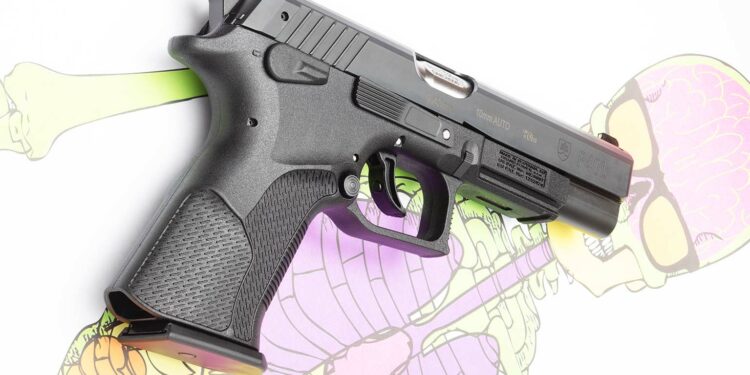By Oleg Volk –
The Grand Power P40L is a rotary breech, polymer-framed 10mm pistol produced in Slovakia. Designed by Jaroslav Kuracina, the inventor of the new rotary action with the K100 Army pistol, this gun lives up to the company brand name with 14+1 rounds of hot 10mm Auto ammunition on board. Why would a 10mm handgun be called a “P40L?” The “L” part is obvious for the “long slide” containing the 5-inch barrel, but why “40?” Turns out P40L is a multicaliber system capable of running .40 S&W with the switchover of the barrel, the recoil spring and the shorter magazine, and the same mag and recoil spring can be used with a .357 SIG barrel.
The 10x25mm Automatic is a cartridge designed around 1983 to fix all the perceived deficiencies of the 9mm Luger. It retains a lively following among hunters and outdoorsmen wanting to anchor venison or to stop a bear charge, but the recoil was judged as excessive for self-defense. Adopted by the FBI in 1989, the 10x25mm Automatic is in current use by their SWAT teams only. The reduced-power 10mm loads were later turned into the shortened .40 S&W loads. The original full-power 10mm is still loaded by numerous ammunition makers large and small, and quite a few autoloaders, revolvers and carbines are chambered for it. The main issue with it remains the heft required to tame the recoil: A Nighthawk® Custom 1911 with a 6-inch barrel shoots comfortably, but the length and the weight of that gun make it a carry choice for the tall and the strong only. Smaller weapons, like the compact GLOCK 29 with a 3.8-inch barrel require some effort to control on recoil—for a weapon that may have to be fired one-handed in a defensive scenario, that’s a downside. Enter Grand Power (GP) with its unique rotary lockup.
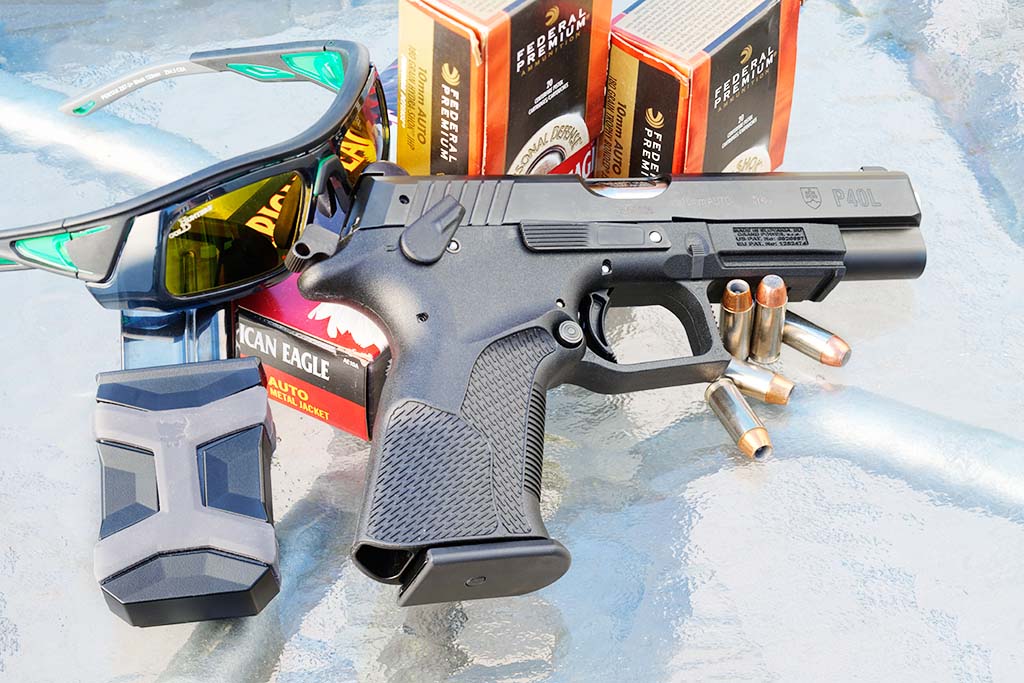
The chamber end of the thick barrel has a machined raceway to fit a solid cross-pin in the frame. Upon firing, the barrel recoils back with the slide for 10mm and then turns against that pin to unlock from the slide. Compared to the conventional tilt-barrel, locked breech that unlocks from the slide almost instantly, Jaroslav’s design requires 40% less recoil spring weight. It also generates about 40% less felt recoil through a much longer unlocking cycle. Compared to the old tab and groove rotary breech design started by Steyr Arms over a century ago and used since by many other gun makers, this mechanism requires significantly less lubrication, allows a lower bore axis and resists wear better to avoid the progressive accuracy-destroying end-shake that plagued older rotary breech guns. A very low friction solution, the GP rotary breech survived 112,000 consecutive test rounds in its 9mm K100 interaction without any perceptible component wear. The 10mm version is suitably beefed up, so it should serve just as long.
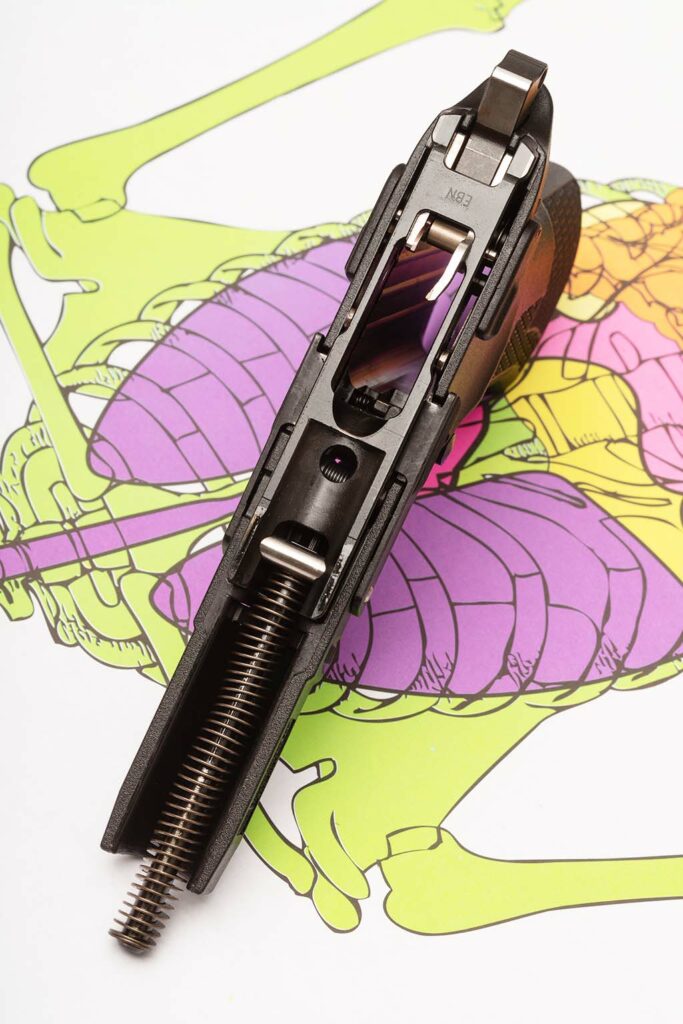
My first experience with the GP 10mm was firing the 4-inch P40 version side by side with a GLOCK 6-inch G40. Both were pleasant to shoot, but I noticed that the shorter and lighter P40 was behaving similarly on recoil and shot every bit as accurately as the GLOCK target model. The long-slide version with a 5-inch barrel, slightly heavier at 38 ounces than the GLOCK, ought to be even easier to shoot well, I thought. Turns out, that was true.
The trigger is a double action/semiautomatic (DA/SA) with a cocked and locked option. For those who find the low-profile ambidextrous safety too slick, extended paddles are available, similar to what’s used on the competition GP X-CALIBUR. The SA breaks at 5.5 pounds, with very light pre-travel and a crisp let-off. Reset is short at about 3mm and quite pronounced, making rapid fire easy. The DA breaks at about 8 pounds, but the trigger bow is too far forward for my index finger to get enough leverage. People with large hands can pull a DA comfortably, the rest of us would be using the cocked and locked option.
The sights are low-profile notched and post with painted white dots. They are adjustable for windage only. The sight picture is sharp, but I have habitual misgivings about the polished surface of the snagless, rear sight frame that might catch reflections from the sky above. Fortunately, replacement sights of several types are available, including a fiber-optic front, a plain and illuminated rear and even the HIVIZ® H3 Tritium and fiber-optic combination designed for CZ but compatible with GP slides. Half-way between the G20 and G40 in terms of sight radius, the P40L proved more accurate than either in my hands. Felt recoil was also less pronounced, to the point where I could run 150 rounds in a session without discomfort. This 10mm resembled a conventional 9mm service pistol in terms of recoil.
Disassembly / Reassembly
Disassembly is quite simple: Pull down two takedown tabs on the sides of the dust cover, rack the slide back and then lift it up to disengage from the frame tabs in the rear. The back of the slide lifts in the manner that is familiar with the Walther PPK and the Marakov pistol. The articulated recoil rod is attached to the frame. The assembly is where the Browning scheme comes out ahead. The barrel has to be placed in the slide and oriented in a particular way in order to engage the locking roller bearing in the steel frame that’s hidden inside the polymer grip frame. The physical effort required for reassembly is less however. The guns stays very clean for several reasons: The chamber pressure drops more by the time extraction begins, the locking surfaces are further from the chamber, and the pistol runs with less oil than other rotary designs. It’s also an inherently safe design, with the thick barrel featuring a fully supported chamber.
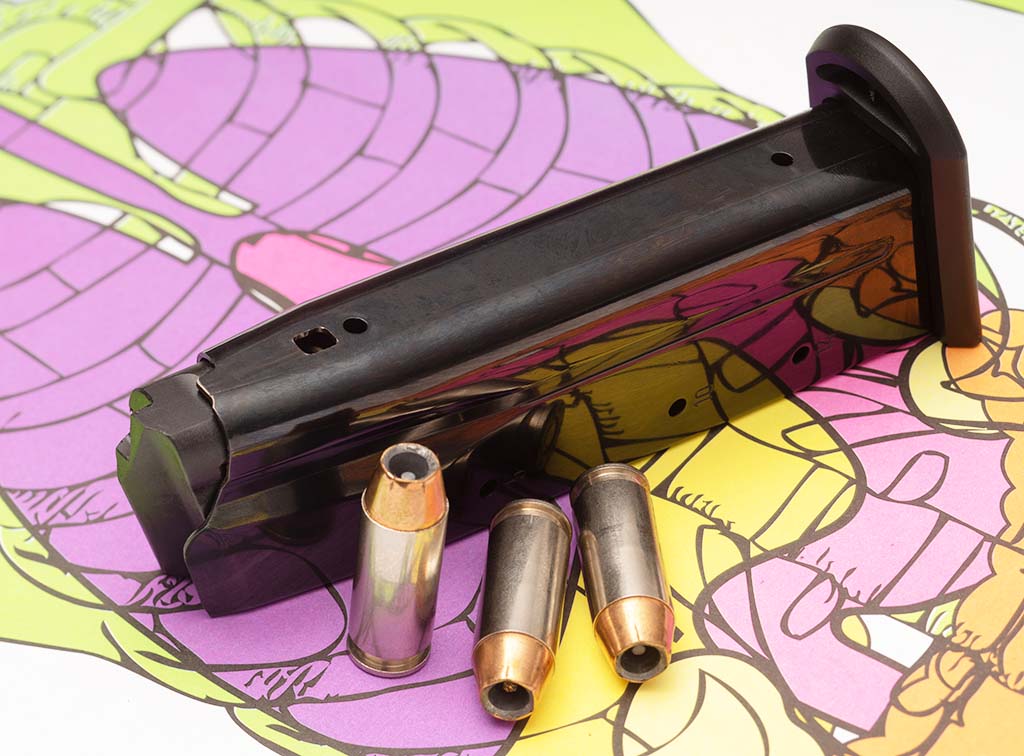
Ammunition Round-Up
Five inches is enough for 10mm Auto to realize most of its potency. On the low-power end, we have 180-grain practice ball ammunition barely more energetic than .40 S&W, and on the high end a vast variety of options from hyper-velocity hollow points to heavy cast hog penetrators. Lucky Gunner® did extensive testing of its ammunition offerings and found that Federal 10mm JHP in 155 grain and 180 grain performed more consistently than the slower .40 S&W with the same weight projectiles, producing 0.64- to 0.68-inch mushrooms and just enough penetration for stopping humans. All-copper Steinel 140-grain comes out at 1,530 fps and expands to 0.70 inch with sufficient penetration. Steinel’s super-dense, 220-grain hard cast lead only trucks at 1,170 fps but will punch through all manner of gristle plate and skull bone … or auto glass and bodies. Compared to the standard 9mm Luger, the 10mm expands more and penetrates deeper. All that comes at the cost of slowed follow-up shots … but the unique Grand Power action reduces that disadvantage. A 10mm GP is still slower than a 9mm GP, but on par with the tilt-barrel designs of other brands.
Drop-free metal magazines hold 14 rounds. The magazine release button is stiffly positive and can be activated from either side. This author lacks the thumb strength to drop the magazine without shifting my hand for leverage, and the button is fenced by a grip ridge which means no accidental mag drops ever. The empty magazine gets launched from the grip with a healthy initial velocity. The slide stop lever is ambidextrous and accessible without being in the way. The grip isn’t adjustable in any way; fortunately, I found it a perfect fit—the sights line up just right upon presentation. The grip is textured just enough to promote retention without abrading the skin on recoil.
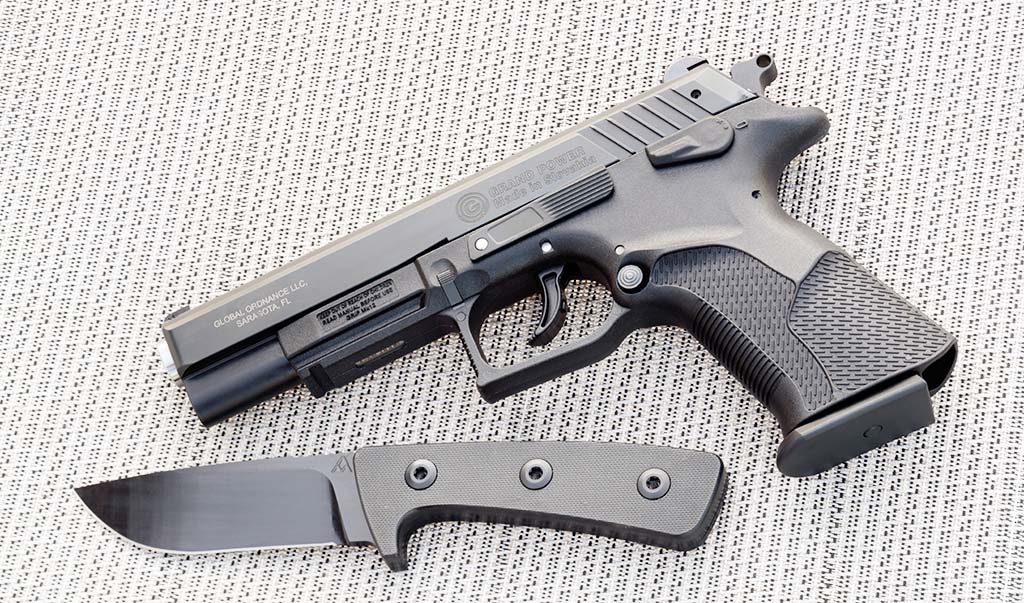
P40L’s Accuracy
Practical accuracy is limited mainly by the steadiness of the shooter’s hand and by the precision of the sight alignment. Fifty yards on a full-size silhouette is an easy shot with the P40L. One hundred yards can be achieved, it just takes some experience with the specific ammunition in the gun—points of impact at that distance can vary by nearly a foot from the weakest to the strongest loads. I would recommend zeroing for the carry ammo and accepting minor deviations from the point of aim with practice ball.
While relatively few companies make holsters, Falco offers numerous nylon, leather and Kydex options, with or without room for lights. With the proven record of reliability and durability, Grand Power P-series handguns are good sidearms. The 10mm, the most energetic of the lot, is plenty controllable and can be used for daily carry, as well as for extensive range practice. At the time when 9mm Luger is hard to find, the 10mm Auto is still available. And you get to carry the caliber designated by science fiction writers David Weber and L. Neil Smith as the choice of the future spacefarers!
| This article first appeared in Small Arms Review V25N1 (January 2021) |



